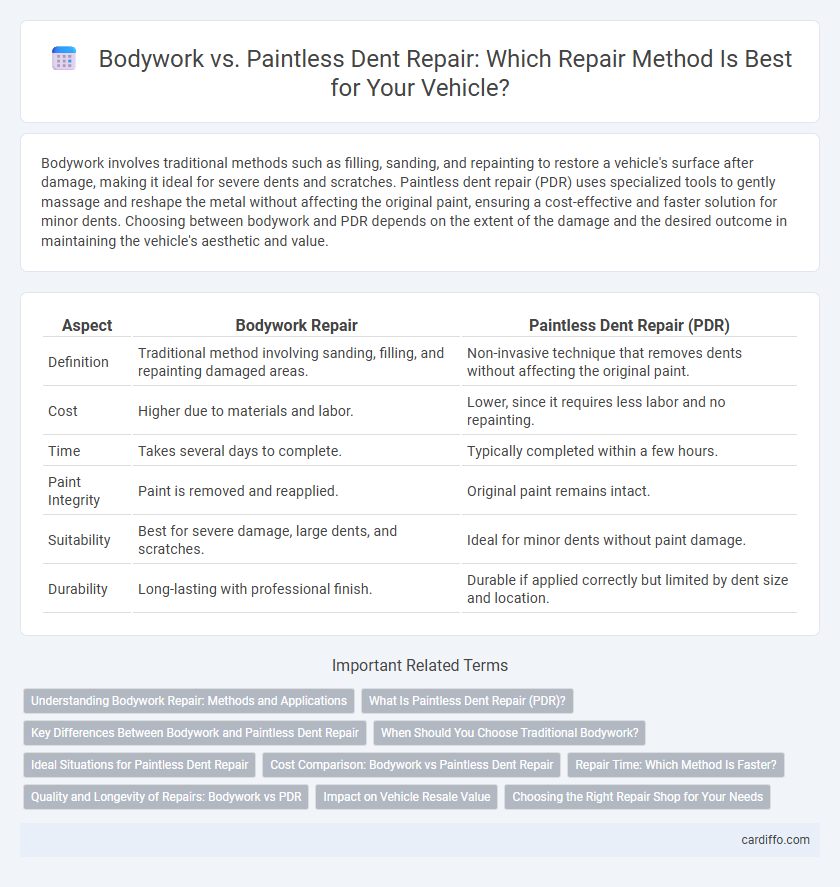Bodywork involves traditional methods such as filling, sanding, and repainting to restore a vehicle's surface after damage, making it ideal for severe dents and scratches. Paintless dent repair (PDR) uses specialized tools to gently massage and reshape the metal without affecting the original paint, ensuring a cost-effective and faster solution for minor dents. Choosing between bodywork and PDR depends on the extent of the damage and the desired outcome in maintaining the vehicle's aesthetic and value.
Table of Comparison
| Aspect | Bodywork Repair | Paintless Dent Repair (PDR) |
|---|---|---|
| Definition | Traditional method involving sanding, filling, and repainting damaged areas. | Non-invasive technique that removes dents without affecting the original paint. |
| Cost | Higher due to materials and labor. | Lower, since it requires less labor and no repainting. |
| Time | Takes several days to complete. | Typically completed within a few hours. |
| Paint Integrity | Paint is removed and reapplied. | Original paint remains intact. |
| Suitability | Best for severe damage, large dents, and scratches. | Ideal for minor dents without paint damage. |
| Durability | Long-lasting with professional finish. | Durable if applied correctly but limited by dent size and location. |
Understanding Bodywork Repair: Methods and Applications
Bodywork repair involves techniques such as welding, panel replacement, and filler application to restore damaged vehicle surfaces to their original shape and structure. This method is essential for extensive dents, rust repairs, or structural damage that cannot be addressed by paintless dent repair (PDR). Understanding the specific damage type and extent is crucial in determining whether conventional bodywork or PDR is the most effective solution for vehicle restoration.
What Is Paintless Dent Repair (PDR)?
Paintless Dent Repair (PDR) is a specialized technique that removes minor dents and dings from a vehicle's body without disturbing the original paint finish. This method uses specialized tools to gently massage and reshape the metal back to its original form, preserving the factory paint and avoiding costly repainting. PDR is ideal for repairing hail damage, door dings, and small creases, offering a faster and more cost-effective alternative to traditional bodywork.
Key Differences Between Bodywork and Paintless Dent Repair
Bodywork involves filling, sanding, and repainting to restore damaged vehicle panels, making it suitable for large dents, scratches, and paint damage. Paintless Dent Repair (PDR) uses specialized tools to gently massage dents back to their original shape without affecting the paint, ideal for minor dings and hail damage. Key differences include the extent of damage each method can address, repair time, and cost efficiency, with PDR typically being faster and more affordable but limited to paint-intact dents.
When Should You Choose Traditional Bodywork?
Traditional bodywork should be chosen when dents are deep, paint has been damaged, or when the metal is creased and requires reshaping. This repair method is essential for extensive damage involving complex body panels, corrosion, and rust removal, ensuring structural integrity. It is the preferred option when repainting is necessary to restore the original finish and color match.
Ideal Situations for Paintless Dent Repair
Paintless dent repair (PDR) is ideal for minor dents and dings where the vehicle's original paint remains intact, such as hail damage, door dings, or small creases. PDR is most effective on flat surfaces or gentle curves without sharp edges or deep scratches, preserving the factory finish and maintaining the car's resale value. This method offers a cost-effective and eco-friendly alternative to traditional bodywork, reducing repair time and eliminating the need for repainting.
Cost Comparison: Bodywork vs Paintless Dent Repair
Bodywork repair often involves higher costs due to labor-intensive procedures, materials, and repainting, typically ranging from $500 to $2,000 depending on damage severity. Paintless dent repair (PDR) is a more cost-effective alternative, with prices usually between $75 and $500, as it preserves the original paint and requires less labor. Choosing PDR can result in significant savings when dealing with minor dents, while bodywork remains necessary for severe damage or paint issues.
Repair Time: Which Method Is Faster?
Paintless dent repair typically requires less time than traditional bodywork because it involves massaging the dent from behind the panel without repainting. Bodywork involves processes such as sanding, filling, and repainting, which can extend repair times from days to weeks depending on the damage extent. Choosing paintless dent repair accelerates turnaround time, especially for minor dents where paint remains intact.
Quality and Longevity of Repairs: Bodywork vs PDR
Bodywork repairs involve panel replacement and extensive sanding, ensuring a durable and high-quality finish suitable for severe damage, while paintless dent repair (PDR) preserves the original paint, offering a quick, cost-effective solution for minor dents without compromising the surface integrity. Bodywork provides long-lasting results that withstand environmental factors, whereas PDR maintains factory paint quality but is less effective for deep or creased dents, potentially affecting longevity. Choosing between methods depends on damage severity and desired durability, with bodywork favored for comprehensive restoration and PDR for maintaining original aesthetics with minimal intervention.
Impact on Vehicle Resale Value
Bodywork repair often involves replacing or repainting damaged panels, which can affect a vehicle's resale value by signaling prior damage and repairs to potential buyers. Paintless dent repair (PDR) preserves the original paint and structure, maintaining the car's factory finish and thus typically supporting higher resale values. Selecting PDR for minor dents helps retain vehicle integrity and consumer confidence in its condition.
Choosing the Right Repair Shop for Your Needs
Choosing the right repair shop requires understanding the differences between bodywork and paintless dent repair services. Bodywork addresses severe damage by reshaping and repainting panels, while paintless dent repair is a cost-effective solution for minor dents without affecting the original paint. Evaluate shop expertise, equipment, and certifications to ensure quality results tailored to your vehicle's repair requirements.
Bodywork vs paintless dent repair Infographic

 cardiffo.com
cardiffo.com